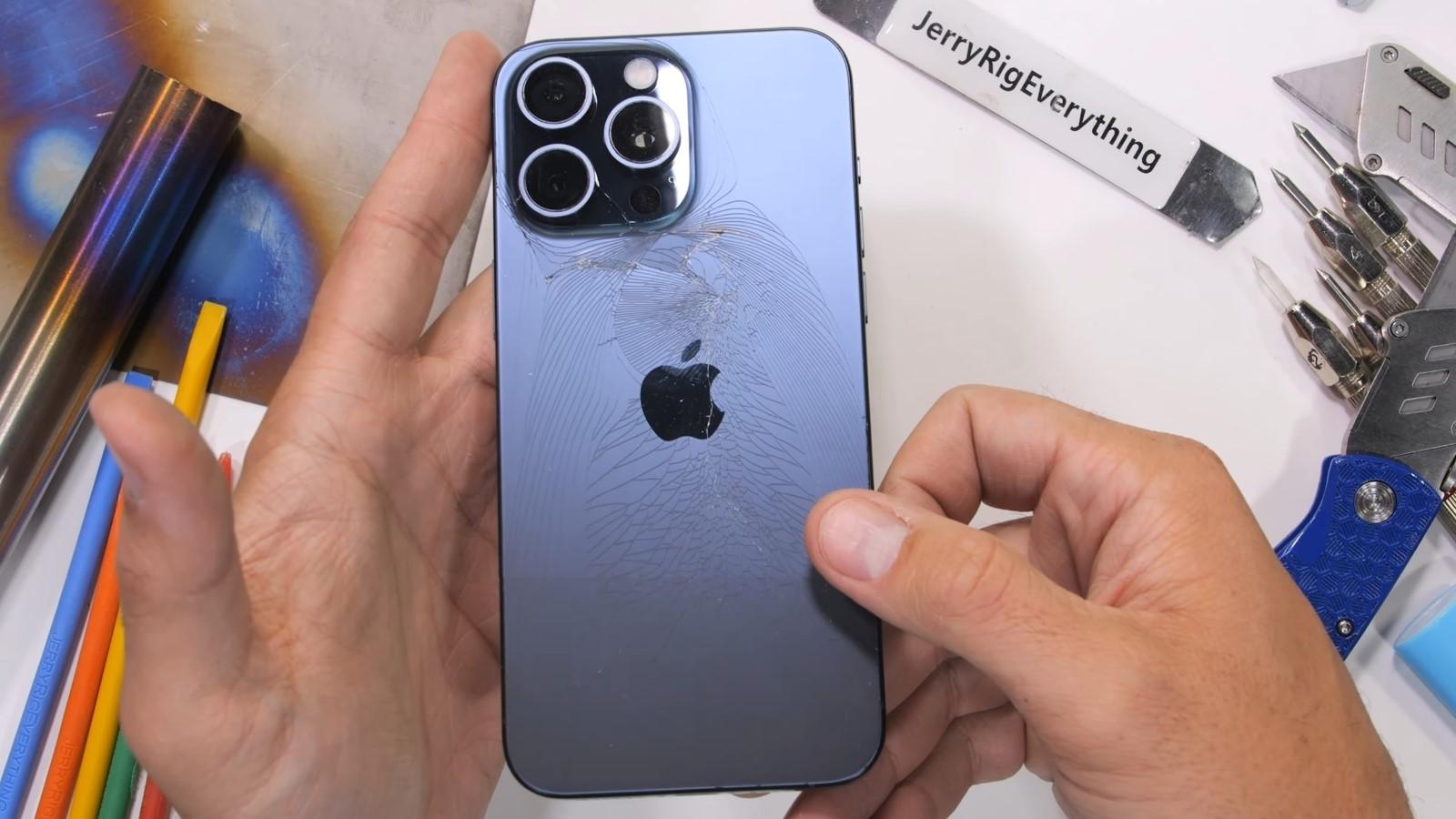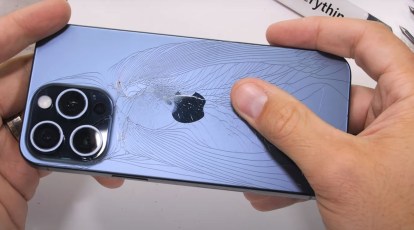Shocking Durability Deficiency: iPhone 15 Pro Max’s Fragile Design Sparks Outrage

Shocking Durability Deficiency: iPhone 15 Pro Max’s Fragile Design Sparks Outrage
In an unexpected turn of events, a prominent tech reviewer, JerryRigEverything, recently posted a video that sent shockwaves through the smartphone community. The video featured the highly anticipated iPhone 15 Pro Max, which suffered a catastrophic failure with only a slight bend. This revelation has ignited a firestorm of reactions from users and experts alike, raising concerns about the device’s structural integrity and durability.
The video, which has quickly gone viral, highlights a glaring issue with Apple’s latest flagship smartphone. The iPhone 15 Pro Max, crafted with a luxurious titanium frame and touted as a pinnacle of engineering excellence, fell astonishingly short when subjected to the most basic durability test. JerryRigEverything’s video showcased the device succumbing to pressure with alarming ease, shattering the back glass panel.
The reviewer’s commentary on the video was candid and impactful. He asserted that “the back glass of the Titanium iPhone 15 Pro Max isn’t…ready…for prime time.” This statement has left tech enthusiasts and Apple loyalists alike baffled, as the company has consistently prided itself on delivering premium, durable products.
The online community has been swift to react to this unexpected revelation, with forums and social media platforms buzzing with discussions. One user on a popular tech forum, who goes by the handle X, expressed their dismay, saying, “So many bad reviews coming out about… the back breaking super easily.” This sentiment was echoed by numerous others, suggesting that the iPhone 15 Pro Max’s fragility has become a hot topic of concern.

Comparisons between the iPhone 15 Pro Max and its predecessor, the iPhone 14, have been a recurring theme in these discussions. One comment read, “This device is more prone to breaking compared to… iPhone 14.” This stark contrast in durability between the two generations of iPhones has raised questions about Apple’s design choices and quality control measures.
Apple, known for its meticulous attention to detail and rigorous quality assurance processes, now finds itself in the midst of a public relations crisis. Users are demanding answers, and the company’s reputation for crafting premium, robust devices is hanging in the balance.
The question on everyone’s mind is: How did Apple, a tech giant renowned for its innovation, let such a fundamental flaw slip through the cracks? To understand the gravity of this situation, it’s essential to delve deeper into the iPhone 15 Pro Max’s design and what may have led to its shockingly poor performance in the durability test.
The Titanium Frame Conundrum
One of the iPhone 15 Pro Max’s standout features is its titanium frame. This choice of material was intended to convey a sense of luxury and sturdiness, setting it apart from its competitors. However, it now appears that this very frame might be the Achilles’ heel of the device.
Titanium is known for its lightweight yet robust properties, making it a preferred choice for high-end products, including aerospace components. However, it is also notoriously difficult to work with, requiring precise engineering and manufacturing techniques. Any deviation from these standards can result in structural weaknesses.
It’s possible that in the pursuit of aesthetics and elegance, Apple may have pushed the boundaries of titanium’s capabilities, resulting in a frame that is more susceptible to bending and deformation than expected. While the use of titanium may have enhanced the phone’s premium feel, it may have compromised its durability.

Quality Control Under Scrutiny
Apple’s stringent quality control processes have long been a cornerstone of its brand identity. However, the widespread reports of iPhone 15 Pro Max’s fragility raise concerns about whether these processes have been upheld.
The tech community is now asking whether the company’s quality control measures failed to detect the vulnerability of the device’s glass back. Such a crucial oversight could indicate a lapse in Apple’s meticulous testing procedures or a rush to bring the iPhone 15 Pro Max to market.
Moreover, questions are being raised about whether the company’s drive to make the device thinner and more aesthetically pleasing came at the expense of structural integrity. Apple has always had an eye for sleek design, but this time, it appears that form may have triumphed over function.
The Impact on Consumer Trust
Apple has built a loyal customer base over the years, and trust in the brand has been a vital factor in its success. The shockingly fragile nature of the iPhone 15 Pro Max has not only disappointed users but also eroded that trust.
Consumers invest significant sums in Apple’s flagship products, expecting them to be reliable and long-lasting. The revelation that the iPhone 15 Pro Max is susceptible to damage from what should be everyday wear and tear has left many feeling betrayed.
The consequences of this breach of trust extend beyond the immediate fallout. Apple may face a decline in sales, as potential customers hesitate to invest in a device with a tarnished reputation for durability. Competitors in the smartphone market may see an opportunity to gain market share by highlighting their own devices’ sturdiness.
Apple’s Response and the Path Forward
As the storm of criticism continues to brew, all eyes are on Apple’s response. The company has a track record of addressing issues promptly and decisively when they threaten its reputation. Apple must now navigate the delicate task of acknowledging the problem and offering a solution that will restore faith in its products.
It is possible that Apple will initiate a recall or repair program for affected iPhone 15 Pro Max units, providing free replacements or repairs for users who have experienced issues. Such a move would demonstrate a commitment to customer satisfaction and product quality.
Additionally, Apple may need to reevaluate its design and manufacturing processes to prevent a similar debacle in future product releases. The focus should not only be on aesthetics but also on building devices that can withstand the rigors of daily use.

In Conclusion
The shocking revelation of the iPhone 15 Pro Max’s fragility has sent shockwaves through the tech community and among Apple enthusiasts. JerryRigEverything’s video highlighting the device’s failure under minimal stress has sparked outrage and widespread concern.
Apple, known for its meticulous attention to detail and quality control, is facing a public relations crisis as users demand answers about how such a fundamental flaw made it into their flagship product. The choice of titanium for the frame and the compromise between aesthetics and durability are under scrutiny.
The impact of this revelation extends beyond immediate disappointment, affecting consumer trust and potentially influencing purchasing decisions. Apple’s response to this crisis and its commitment to addressing the issue will determine how it weathers this storm and whether it can regain the trust of its loyal customer base.
In the world of technology, where innovation is relentless, Apple’s reputation for quality and durability has been a cornerstone of its success. The fragility of the iPhone 15 Pro Max serves as a stark reminder that even giants can stumble, and that trust once eroded is not easily rebuilt. The tech world watches with bated breath to see how Apple navigates this challenging chapter in its storied history.
The repercussions of the iPhone 15 Pro Max’s durability issue are reverberating across the tech industry. Competing smartphone manufacturers are closely monitoring the situation, seeing it as an opportunity to gain an edge in a fiercely competitive market. If Apple’s loyal customer base begins to waver due to concerns about product quality, it could open the door for rival brands to woo consumers with more robust offerings. This could potentially reshape the smartphone landscape and disrupt Apple’s dominant position.
In addition to the impact on consumers and competitors, the incident has also sparked conversations about sustainability. The fragility of smartphones like the iPhone 15 Pro Max raises questions about the environmental impact of frequent replacements and repairs. Electronic waste is a growing concern, and if consumers perceive the latest iPhones as more disposable due to durability issues, it could trigger debates about the industry’s responsibility to produce longer-lasting devices that reduce e-waste.
Furthermore, the iPhone 15 Pro Max’s failure highlights the ever-present challenge for tech companies to strike a balance between innovation and reliability. As consumers demand sleeker and more feature-packed devices, manufacturers are under pressure to deliver cutting-edge products. However, this pursuit of innovation must not come at the expense of basic functionality and durability. Tech companies, including Apple, will need to reevaluate their design and testing processes to ensure that future products meet the high expectations of users.
In conclusion, the iPhone 15 Pro Max’s unexpected fragility has cast a shadow over Apple’s reputation for quality and durability. It has ignited discussions about the company’s design choices, quality control processes, and the impact on consumer trust. Beyond these immediate concerns, the incident could reshape the smartphone market, influence sustainability discussions, and underscore the delicate balance between innovation and reliability in the tech industry. Apple’s response to this crisis will not only define its future success but also set a precedent for how tech giants navigate challenges to their brand integrity.




